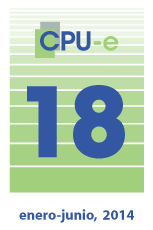Resumen
Esta contribución busca comprender las dificultades que encuentran 329 estudiantes de sexto de primaria y tercero de secundaria al enfrentar un problema del campo conceptual de las estructuras multiplicativas, la relación de esas dificultades con los sistemas de representación y con los teoremas-en-acto sobre la división. Los resultados muestran que una tercera parte resuelve correctamente el problema, casi la mitad de quienes no lo hacen invierte los datos en la división y esto puede deberse a la idea de que “el número grande siempre es el dividendo y el número pequeño es el divisor”, aunado a que no consideran la factibilidad real de la respuesta dada. Otras dificultades corresponden a la asignación de unidades de longitud a números decimales.
Abstract
This contribution seeks to understand the difficulties encountered by 329 students in sixth grade and ninth grade to address a problem of conceptual field of multiplicative structures, the relationship of these difficulties with the systems of representation and theorems-in-action on the division. The results show that one-third correctly resolve the problem, almost half of those who do not, inverting the data in the division and this may be due to the idea that “the big number is always the dividend and the smaller the number divisor”, together they do not consider the actual feasibility of the answer, other difficulties relate to the allocation of units of length to decimal numbers.
Recibido: 04 de febrero de 2013
Aceptado: 19 de junio de 2013
Citas
Brousseau, G. (1997). Theory of didactical situations in mathematics. Dordrecht, Netherlands: Kluwer Academic Publishers.
Chain, R., Ortega, J., Vaca, J. E., Bustamante, A. J., Ojeda, M., Velasco, F., Hernández, M., & López, J. (2009). Sistema de consulta CONAFE. ENLACE 2008. Manuscrito inédito, Instituto de Investigaciones en Educación, Universidad Veracruzana, Xalapa, México.
Fischbein, E., Deri, M., Sainati, M., & Sciolis, M. (1985). The role of implicit models in solving verbal problems in multiplication and division. Journal for Research in Mathematics Education, 16(1), 3–17.
Instituto Nacional de Evaluación Educativa. (2013). Reactivos liberados PISA 2003. Recuperado de http://www.inee.edu.mx/index.php/servicios/pisa/reactivos–liberados–pisa–2003
Rockwell, E. (Coord.). (2005). La escuela cotidiana. México: Fondo de cultura económica.
Schwartz, J. L. (1988). Intensive quantity and referent transforming arithmetic operations. En J. Hiebert & M. Behr (Eds.), Number concepts and operations in the middle grades (pp. 41–52). New Jersey: Lawrence Erlbaum.
Secretaría de Educación Pública. (2012). Hacia PISA 2009. Recuperado de http://www.pisa.sep.gob.mx/pisa_en_mexico.html
Vaca, J. E., Bustamante, A. J., Gutiérrez, F. M., & Tiburcio, C. (2010). Los lectores y sus contextos. Recuperado de http://www.uv.mx/bdie/files/2012/10/Lectores_marcoteorico.pdf
Vergnaud, G. (1990). La théorie des champs conceptuels. Récherches en didactique des Mathématiques, 10(2), 133–170.
Vergnaud, G. (1994). Multiplicative Conceptual Field: What and Why? En The Development in Multiplicative Reasoning in the Learning of Mathematics (pp. 41–61). Albany: State University of New York Press.
Vergnaud, G. (2001). Problemas aditivos y multiplicativos. En E. Fernández (Coord.), Dificultades del aprendizaje de las matemáticas (pp. 189–228). España: Ministerio de Educación, Cultura y Deporte.
Vergnaud, G. (2004). El niño, las matemáticas y la realidad: Problemas de la enseñanza de las matemáticas en la escuela primaria. México: Trillas
Vergnaud, G. (2009). The theory of conceptual fields. Human Development, 52(2), 83–94.
Los autores son los legítimos titulares de los derechos de propiedad intelectual de sus respectivos artículos, y en tal calidad, al enviar sus textos expresan su deseo de colaborar con CPU-e, Revista de Investigación Educativa, editada por el Instituto de Investigaciones en Educación de la Universidad Veracruzana.
Por lo anterior, de manera libre, voluntaria y a título gratuito, una vez aceptado el artículo para su publicación, ceden sus derechos a la Universidad Veracruzana para que el Instituto de Investigaciones en Educación reproduzca, edite, publique, distribuya y ponga a disposición dicha obra a través de intranets, internet o dispositivos de almacenaje, sin limitación alguna de forma o tiempo, siempre y cuando sea sin fines de lucro y con la obligación expresa de respetar y mencionar el crédito que corresponde a los autores en cualquier utilización que se haga del mismo.
Queda entendido que esta autorización no es una cesión o transmisión de alguno de sus derechos patrimoniales en favor de la mencionada institución, ni tampoco una licencia exclusiva, pues sólo tendrá una vigencia de seis meses a partir de la fecha de publicación.

CPU-e, Revista de investigación Educativa,
así como todos sus contenidos están bajo una
Licencia Creative Commons
Atribución-NoComercial 4.0 Internacional.

